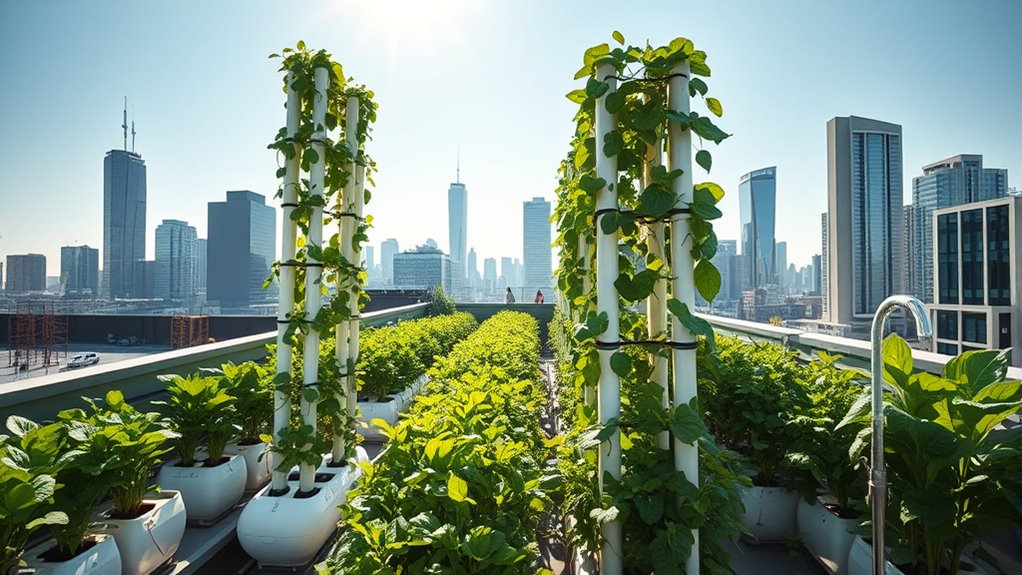In 600 square feet, aeroponics can revolutionize your urban garden by efficiently growing a variety of plants without soil. You’ll suspend roots in a closed chamber, where they’re misted with nutrients for faster growth and higher yields. This method minimizes space and resource use while protecting plants from pests and soil-borne diseases. With proper setup and maintenance, you can enjoy year-round fresh produce. Stay with us to discover how to master this innovative gardening technique.
Key Takeaways
- Aeroponics maximizes small spaces by suspending plant roots and delivering nutrients via mist, ideal for 600 sq ft urban gardens.
- Setting up involves a sturdy frame, misting system, and nutrient reservoir, ensuring even coverage for healthy plant growth.
- Regular maintenance of pH, nutrients, and system cleanliness prevents clogs and mold, supporting year-round food production.
- Pest management is simplified in closed aeroponics systems, with organic methods like neem oil and beneficial insects as needed.
- Promotes faster growth, higher yields, and a deeper connection to food sources within compact urban environments.

Urban Gardening 2.0 is redefining how city dwellers connect with nature and grow their own food. If you’re just starting out, aeroponics offers a groundbreaking method that fits perfectly within a 600-square-foot space. It’s an innovative form of soil-free gardening that uses a mist or air to deliver nutrients directly to plant roots. This approach maximizes your limited space and minimizes resource use, making it ideal for urban environments.
To begin, you’ll want to understand hydroponic systems, which form the backbone of aeroponics. Unlike traditional soil-based gardening, hydroponic setups rely on nutrient-rich water or mist to feed plants. Aeroponics takes this a step further by suspending roots in an enclosed environment, where they’re regularly sprayed with a finely tuned nutrient solution. This method promotes faster growth, higher yields, and less space consumption. Plus, because plants aren’t rooted in soil, you avoid many common soil-borne pests and diseases, reducing the need for chemical pest management. When pests do appear, your system’s controlled environment makes it easier to identify and manage issues swiftly, using integrated pest management strategies that focus on prevention and biological controls rather than chemicals.
Setting up your aeroponic system is straightforward. You’ll need a sturdy frame, a misting system, and a reservoir of nutrients. Position your plants so their roots hang freely in the mist chamber, ensuring they receive consistent, even coverage. This setup allows you to grow a variety of greens, herbs, and even small vegetables all within your compact space. As you operate the system, pay close attention to pest management. Since your plants are in a closed environment, pests are less likely to become a major problem, but vigilance is key. Regularly inspect your plants for signs of pests or disease, and use organic methods like neem oil or introducing beneficial insects if needed. Incorporating proper lighting conditions can further enhance plant growth and health.
Maintaining your aeroponic garden requires regular monitoring of pH levels, nutrient concentrations, and system cleanliness. Because you’re working with water-based systems, it’s essential to prevent clogs in the misting nozzles and keep the environment sterile to avoid mold or bacterial growth. This proactive approach to pest management, combined with the efficiency of hydroponic systems, ensures your urban garden thrives with minimal effort. In just a small space, aeroponics empowers you to grow fresh, healthy food year-round, connecting you more deeply with your environment and your food source.
Frequently Asked Questions
What Are the Initial Costs of Setting up an Aeroponics System?
The initial costs of setting up an aeroponics system depend on your equipment investment and the scale of your project. You’ll need to evaluate a cost analysis for items like grow misters, pumps, nutrient solutions, and support structures. While the setup can be affordable for small spaces, expect to spend more if you want a highly automated or large system. Planning your budget carefully ensures you get quality equipment without overspending.
How Much Maintenance Does an Aeroponics Garden Require Weekly?
They say “a little maintenance goes a long way,” and that’s true for aeroponics gardens. You’ll check lighting requirements weekly, ensuring plants get enough light, and monitor nutrient management to keep plants healthy. Expect to clean the system, top off nutrient solutions, and inspect for clogs or pests once a week. With regular care, your aeroponics setup stays productive and efficient, making gardening both rewarding and manageable.
Can Aeroponics Be Integrated With Traditional Soil Gardening?
You can definitely integrate aeroponics with traditional soil gardening. It allows you to experiment with soil compatibility and expand plant diversity. By combining both systems, you optimize space and resources, benefiting from rapid growth in aeroponics while maintaining soil-dependent plants. Just guarantee proper planning to prevent pests or disease transfer, and adjust watering and nutrients accordingly. This hybrid approach creates a versatile, sustainable garden suited to your space and goals.
What Are the Common Pests and Diseases in Aeroponics?
In aeroponics, pests like aphids and spider mites can still pose problems, and diseases such as root rot or mold may develop if you’re not vigilant. To keep pests at bay, practice pest prevention by monitoring plants regularly and maintaining cleanliness. For disease management, guarantee proper airflow and avoid overwatering. Consistent inspection and prompt treatment are key to keeping your aeroponic system healthy and productive.
How Scalable Is Aeroponics for Larger Urban Spaces?
Thinking big can be a tall order, but aeroponics scales surprisingly well for larger urban spaces. You’ll face scalability challenges like maintaining uniform nutrient delivery and optimizing urban space efficiently. With proper planning, automation, and modular systems, you can expand your setup without sacrificing efficiency. Aeroponics offers great potential for urban space optimization, letting you grow more food in less room while overcoming hurdles that come with larger-scale operations.
Conclusion
As you step into the world of aeroponics, your 600-square-foot haven transforms into a lush symphony of growth, each plant reaching for the sun like dancers stretching to their debut. With hands in the air and roots in the sky, you become both conductor and nurturer, orchestrating an urban oasis that defies the concrete jungle. Embrace this new chapter—your garden’s heartbeat will echo through every leaf, turning small space into a sprawling forest of possibility.









